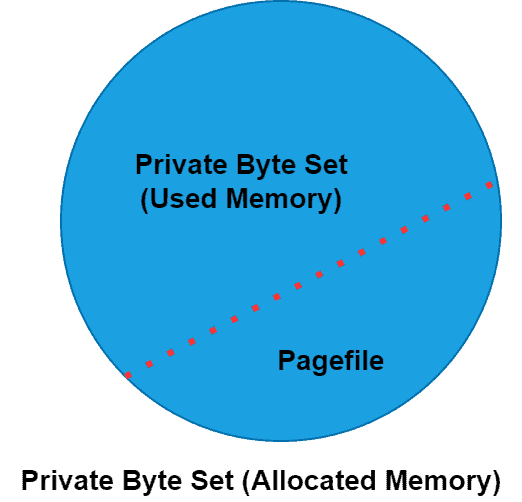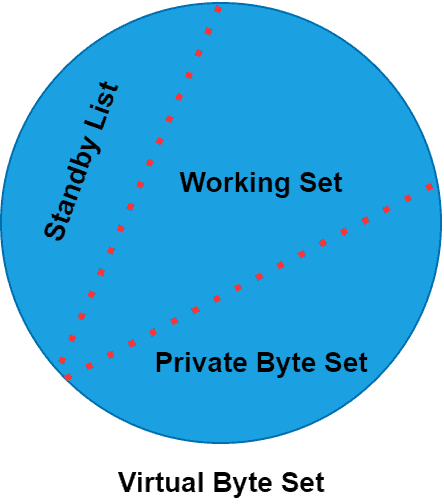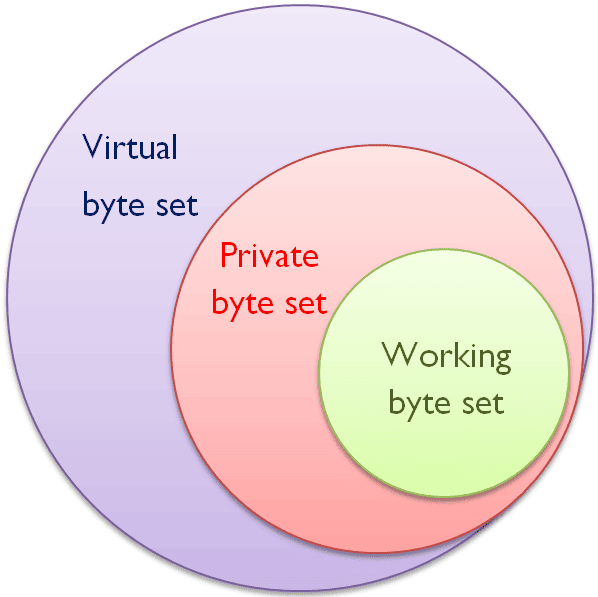1. 概述
在本篇文章中,我们将深入探讨操作系统中三个与内存相关的核心概念:
- Private Bytes
- Virtual Bytes
- Working Set
这些概念在性能监控、内存分析和排查内存泄漏等问题时非常关键。我们将分别解释它们的含义,并通过示例代码和图表帮助理解,最后总结它们之间的核心差异。
2. Private Bytes
✅ Private Bytes 表示进程在运行或执行前向操作系统申请的私有内存总量。
它反映的是已分配但不一定被实际使用的内存。这部分内存不会与其他进程共享,通常包括堆栈、堆内存和页面文件(pagefile)等。
⚠️ 注意:Private Bytes 是已分配内存的估算值,而非实际使用值。即使程序没有使用全部分配的内存,该值也不会减少。
用途:
- 监控内存泄漏:如果 Private Bytes 持续增长,可能意味着程序中存在内存泄漏。
- 分析内存使用趋势。
示例代码(C# 获取 Private Bytes):
using System.Diagnostics;
class Program
{
static void Main()
{
Process process = Process.GetCurrentProcess();
Console.WriteLine($"Private Bytes: {process.PrivateMemorySize64 / 1024} KB");
}
}
特点:
- 不包括内存映射文件(Memory-Mapped Files)
- 包括页面文件(Pagefile)
- 内存不能与其他进程共享
图示说明:

3. Working Set
✅ Working Set 是当前驻留在物理内存中的进程页面集合。
可以理解为:当前进程正在使用的、且已经被加载到 RAM 中的内存页。
核心机制:
- 当进程访问一个不在 Working Set 中的页面时,会触发 Page Fault(缺页异常)。
- Page Fault 可分为:
- ✅ Soft Page Fault:页面在内存中,但不在当前 Working Set 中
- ❌ Hard Page Fault:页面需要从磁盘读取(如页面文件)
Working Set 的变化:
- 页面被访问后加入 Working Set
- 页面长时间未使用会被移出,变为 Transition Page
- 页面可以被多个进程共享(如共享库)
示例代码(C# 获取 Working Set):
using System.Diagnostics;
class Program
{
static void Main()
{
Process process = Process.GetCurrentProcess();
Console.WriteLine($"Working Set: {process.WorkingSet64 / 1024} KB");
}
}
特点:
- 包括非分页私有内存和内存映射文件
- 页面可以被其他进程共享
- 是 Private Bytes 的子集
4. Virtual Bytes
✅ Virtual Bytes 是进程的虚拟地址空间总大小。
虚拟内存通过页表(Page Table)将虚拟地址映射到物理地址,使得每个进程都拥有独立的地址空间。
核心概念:
- 虚拟地址 ≠ 物理地址
- 虚拟内存可以大于物理内存,通过磁盘交换空间(Swap Space)实现
- 支持内存保护、共享和按需加载
示例代码(C# 获取 Virtual Bytes):
using System.Diagnostics;
class Program
{
static void Main()
{
Process process = Process.GetCurrentProcess();
Console.WriteLine($"Virtual Bytes: {process.VirtualMemorySize64 / 1024} KB");
}
}
Virtual Bytes 的组成:
- Working Set
- Private Bytes
- Standby List(备用页面列表)
图示说明:

5. 核心差异对比
| 属性 | Private Bytes | Working Set | Virtual Bytes |
|---|---|---|---|
| 含义 | 进程私有内存总量 | 当前驻留在物理内存中的页面集合 | 进程的虚拟地址空间总大小 |
| 是否共享 | ❌ 不可共享 | ✅ 可能包含共享内存 | ✅ 包含共享内存 |
| 是否包含磁盘内存 | ✅ 包括页面文件 | ❌ 不包括磁盘内容 | ✅ 包括磁盘内容 |
| 主要用途 | 检测内存泄漏 | 衡量当前内存使用情况 | 检查系统负载、地址空间限制 |
| 大小关系 | Working Set ⊆ Private Bytes ⊆ Virtual Bytes |
集合关系图示:

6. 总结
本文系统地介绍了操作系统中三个重要的内存概念:
- Private Bytes:私有内存分配总量,用于监控内存泄漏
- Working Set:当前驻留物理内存的页面集合,反映实际内存使用情况
- Virtual Bytes:虚拟地址空间大小,包含所有内存区域
三者之间存在包含关系:
Virtual Bytes ⊇ Private Bytes ⊇ Working Set
在实际开发中,合理使用这些指标可以帮助我们:
- 快速定位内存问题
- 理解系统资源分配机制
- 提升应用性能与稳定性
希望这篇文章能帮助你更深入地理解内存管理机制,避免踩坑。